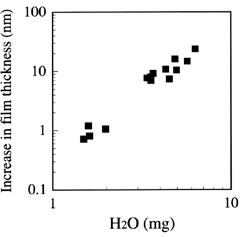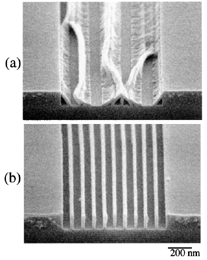
Supercritical Resist Drying for Nanofabrication
Hideo Namatsu
Device Physics Laboratory
To develop new functional devices, it is necessary to form finer patterns. However, when the pattern width is reduced, the height of the pattern cannot be reduced very much. Thus the aspect ratio (height/width) of the pattern increases and the pattern easily collapses. The pattern quickly collapses when the rinse solution is dried in the development and washing processes. It is known that the patterns collapse when the spacing is smaller than the product of the squared aspect ratio, i.e., (spacing) < k ´ (aspect ratio)2 [1]. The constant k depends on the surface tension of the rinse solution. So, to solve this problem, reducing surface tension is good because it can be done on patterns of any size. In particular, the use of supercritical (SC) fluid for drying is the best because the surface tension, which causes pattern collapse, is zero.
Carbon dioxide (CO2) is used because CO2 has a relatively low critical point compared to other fluids and is safe. Conventional SC drying with dry ice or liquid CO2, however, causes resist pattern deformation due to film swelling. The analytical results indicate that the cause is gas release from H2O molecules diffusing into the resist. Namely, the moisture, which condenses on the wall, dissolves in SC CO2. When the pressure is reduced, CO2 associated with H2O molecules is released inside the film. This causes the resist to swell. Figure 1 shows the relationship between increases in film thickness and H2O content in SC CO2. It is clear that the film swelling is closely related to the water content. Furthermore, this figure indicates that reducing the H2O content is the key to obtaining resist patterns without any deformation. Figure 2 shows the resist patterns after drying. Drying with H2O-controlled SC CO2 enables patterns to be formed without collapsing or becoming deformed, whereas fine patterns dried in a simple nitrogen atmosphere collapse. This means that H2O-controlled SC drying is a powerful method of improving the resolution.
[1] H. Namatsu et al., Appl. Phys. Lett. 66(1995) 2655.

Fig. 1: Increase in film thickness vs H2O content.

Fig. 2: Resist patterns dried with (a) nitrogen blow and (b) H2O-controlled SC CO2.